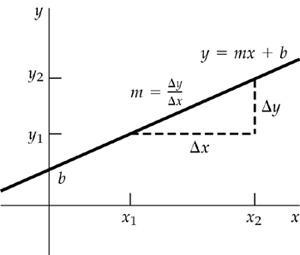Chapter 1. Linear equations
Introduction to linear equations
A linear equation is an equation of the form
x + 2y - 4z = 3
That is, an equation is linear if each term either is constant or is the product of a constant and a variable raised to the first power. Such equations are said to be linear because the plots of these equations form straight lines or planes. The equations of direct proportion between two variables are linear equations.

Graphing linear equations
Linear equations can be plotted on a graph to give a straight line.
Here the equation
y = mx +b is plotted on an x-y axis.
Look closely at the figure shown above and you will see two important features of the straight line graph
The slope
The slope of a line is found by calculating
m=y2−y1x2−x1=ΔyΔx
In a linear equation of this form, m is equal to the slope and has a constant value.
The y intercept
The value of y where the line crosses the y-axis (also called the y-intercept) can be found by letting x = 0 in the equation.
In our equation b = the y intercept.
Given these two values (slope and y-incercept) we can plot a straight line on a graph, the linear equation includes these values.
Try it yourself: Interpreting linear equations
Question Sequence
Question 1.
Write down the slope of these linear x-y equations.
y = 3x + 7
Try it yourself 2 - More practice with linear equations.
Question Sequence
Question 9.
The following linear equations are written in terms of the variables x and y. For each equation solve for either x or y.
For x =6, y = ?
y = 2x – 3
Solving equations with two unknowns
As we saw in the previous exercises, If an equation has only one unknown, then it can be directly solved. However with with more than one unknown variable, we need to use more than one equation to find a unique solution.
For example:
- If x and y are both unknown in the equation y = mx + b, there are no unique values of x and y that are solutions to the equation.
- Any pair of values (x1, y1) at a point on the line will satisfy the equation.

- If we have two equations, each with two unknowns x and y, the equations can be solved simultaneously.
- Plotting the equations on a graph, where the lines cross, there is a single point where both equations are true for the same values of x and y.
P’CAST: USING TWO EQUATIONS TO SOLVE FOR TWO UNKNOWNS
Worked example 2
Two people set off from the same starting point and walk along a path in the x direction at different rates. Person A walks faster at 2m/s but starts walking 3s after person B who walks at 1.5m/s. Use simultaneous equations to figure out how much time has passed when person A passes person B and where they are relative to the start point at that time.
To approach this problem we can use linear simultaneous equations.
1. The first step is to write down equations to describe the motion of each person.
Person A starts walking at time t = 3s at v = 2m/s.
The equation to represent this motion is xA = vAt – vAt0 or xA = 2t - 6
Person B starts walking at time t = 0.
The equation to represent this motion is xB = vB(t) or xB = 1.5t
2. Sketch both of these linear equations on a graph in the same way you did in the previous example – in this case you could plot the distance travelled on the vertical axis and the time taken on the horizontal axis.
3. The solution to these simultaneous equations will be the unique values of x and t that satisfy both equations.
- Note – there is only one point on your graph where both equations have the same x and t values (where the lines cross).
- These values represent the place (x) and time (t) where person A overtakes person B.
4. Now you can solve the problem.
If xA = xB (where the lines cross)
1.5t = 2t - 6
At t = 12s, x = 1.5(t) = 1.5(12) = 18m.
So the solution will be, A passes B at x = 18m after 12s.
Try it yourself: Simultaneous equations
Here are some more problems to practice solving simultaneous equations. Solve each pair of equations for x and y.
Question Sequence
Question 13.
y = -4x + 14
-y = -6x +16